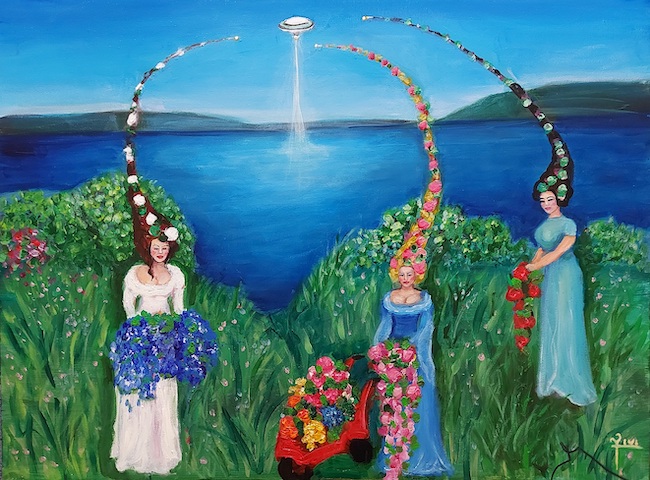La tendenza innata dell’essere umano a interrogarsi sui misteri dell’universo ha sempre contraddistinto un nutrito gruppo di artisti che, ciascuno con il suo personale linguaggio espressivo, hanno raccontato di quella parte di mistero, di inspiegabile, in cui la realtà quotidiana è immersa e che l’uomo spesso dimentica di ascoltare; il compito che si assumono questi creativi è pertanto quello di evidenziare la connessione tra oggettività e sensazione, tra spiritualità e forze superiori che interagiscono con il mondo dando vita a una dimensione parallela che di fatto, seppur silenziosamente, interagisce e guida l’esistenza delle persone. La protagonista di oggi sceglie di lasciar emergere la sottile magia che contorna la vita attraverso uno stile sognante, morbido e rassicurante, con cui narra tutto ciò che di invisibile ruota intorno all’individuo.
Il contatto con la spiritualità è stata lungamente tralasciato, nel corso della storia dell’arte, per dare priorità alla perfezione dei dettagli, all’attinenza alla realtà osservata e il forte legame con le regole accademiche che dovevano determinare una perfezione nella riproduzione dell’immagine che prevalesse su qualsiasi interferenza dell’interiorità dell’artista; tuttavia vi furono alcuni movimenti anche nei secoli precedenti al Ventesimo, giro di boa assoluto dell’approccio all’arte, che decisero di mettere in evidenza proprio quelle energie sottili, quel contatto con la spiritualità e l’interiorità troppo spesso ignorate. Il primo a parlare di immaterialità, di tutto ciò che sembra convivere latente sotto la superficie, fu Hieronymus Bosch, le cui visioni fantastiche e trascendentali mettevano in luce tutto ciò che non era riconducibile e spiegabile dalla ragione; già con lui cominciò a delinearsi un legame con le prime teorie psicanalitiche sull’inconscio che furono oggetto di studio e approfondimento da parte dei molto successivi surrealisti ispirati dagli studi di Sigmund Freud. Alla fine del Diciottesimo secolo, dunque molti decenni dopo, fu fondato in Germania il Romanticismo che metteva in primo piano le sensazioni, la fantasia, l’immaginazione e l’interpretazione del singolo artista rispetto a panorami e scene di eventi storici o mitologici; in questo stile artistico ciò che era importante era il sentimento, la profondità emotiva che doveva trasparire dalle tele per raggiungere le corde interiori dell’osservatore il quale non poteva fare a meno di riflettere su quel mondo intimo di cui l’artista raccontava. A fine Ottocento il Simbolismo riprese le tematiche del sentire, del percepito legandole però più a quell’ascolto delle energie intorno all’essere umano che dovevano essere ascoltate attraverso l’intuizione, la spiritualità attraverso cui indagare tutto ciò che non è visibile all’occhio umano, soggettivizzando le immagini riprodotte con il filtro della sensazione. Con il Ventesimo secolo infine, vi fu una totale apertura nei confronti del mondo emozionale, del contatto con tutto ciò che a livello inconscio circonda l’essere umano, più o meno consapevole; tra i movimenti più rilevanti in tal senso vi furono il Surrealismo, la Metafisica, parte del Naif, quello sudamericano, e infine anche il Realismo Magico, tutti movimenti che intendevano trovare una connessione tra ciò che l’uomo vive quotidianamente e tutte quelle realtà nascoste, sottili e impercepibili che si muovono intorno restando legate a un senso di mistero.
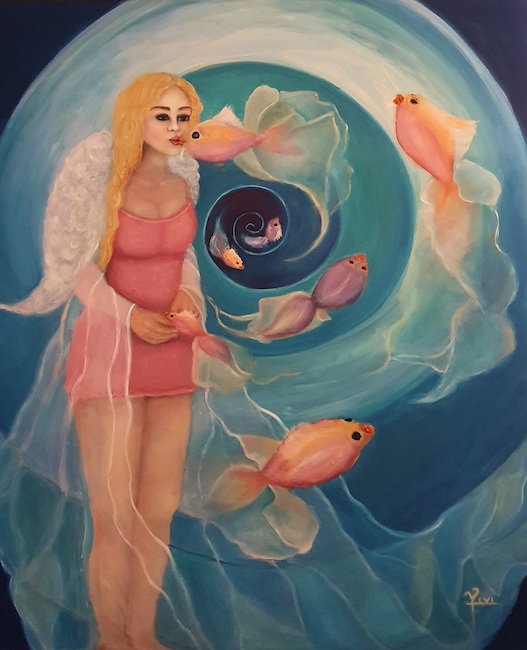
L’artista norvegese Vivi Connors si avvicina sia al Naïf che al Realismo Magico per descrivere il suo mondo in cui il contatto con la natura è la base fondamentale della sua ricerca pittorica poiché descrive l’importante ruolo che l’ambiente che circonda l’uomo svolge nell’accompagnare la quotidianità, e qui si lega al Naïf per la minuziosa descrizione dei particolari e per la miniaturizzazione dei personaggi collocati all’interno del contesto naturale, ma al tempo stesso evoca anche la cornice idilliaca dentro cui trovare la connessione con tutto ciò che ruota invisibile intorno alle protagoniste delle sue tele, mostrando in questo la sua tendenza al Realismo Magico.
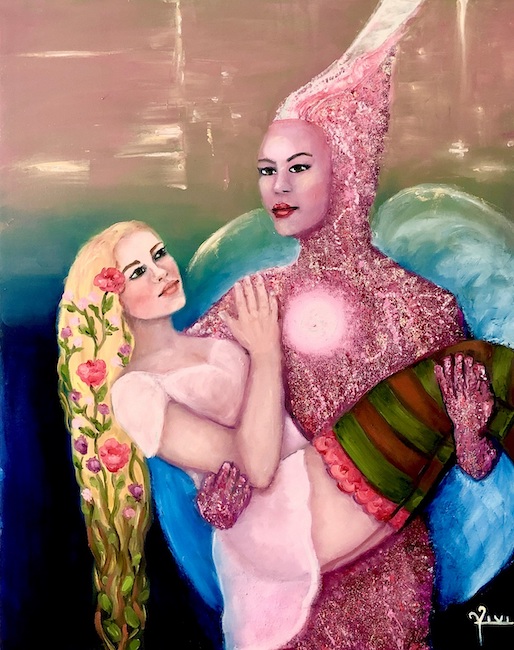
Parla di anime, di incursioni dallo spazio che non appaiono minacciose, tutt’altro, sembrano vigilare e proteggere il mondo che sorvegliano, come se da loro dipendesse la continuazione di quell’armonia necessaria all’essere umano per non smettere di essere, appunto, umano. Il mondo fiabesco della Connors è un invito all’osservatore a non perdere il contatto con il proprio lato bambino, quello grazie al quale è possibile ancora sognare, immaginare luoghi e situazioni differenti da quelle riscontrabili nella realtà eppure ugualmente possibili se solo l’adulto non soffocasse la propria fantasia, la propria immaginazione.

Da questo punto di vista, quello dell’intenzione pittorica, l’artista si avvicina così alle tematiche simboliste anche se nel suo caso il contatto con l’esterno è legato alle emozioni più piacevoli, pure, innocenti che senza timore si pongono in ascolto di tutto quell’alone di mistero, di soprannaturale che inevitabilmente avvolge il quotidiano e che spesso resta inascoltato, un po’ per distrazione, un po’ per superficialità e un po’ per quell’ingestibile paura dell’ignoto che contraddistingue l’uomo di ogni epoca.
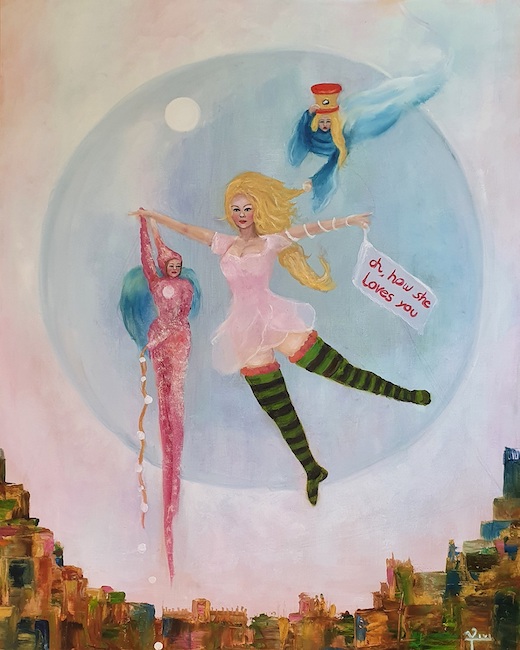
Nella tela She loves you 2 (Lei ti ama 2) Vivi Connors evidenzia invece un’attitudine a lasciarsi andare all’ascolto di quelle energie sottili, non solo, permette anche a quel mondo sussurrato di sollevarla per rassicurarla e mostrarle quanto sia positiva la vicinanza di quelle che sembrano essere creature aliene ma protettive, sorridenti, come se volessero prendersi cura della sua anima e tutelarla dalle avversità; la donna narrata, idealmente l’artista stessa, è dunque felice, serena, appagata dall’osservare il mondo dall’alto della sua sfera di sicurezza. Le tonalità scelte si armonizzano con le atmosfere narrate, giocano con i toni pastello del rosa e del celeste per sottolineare la bellezza di uno sguardo fanciullesco nei confronti del mondo.
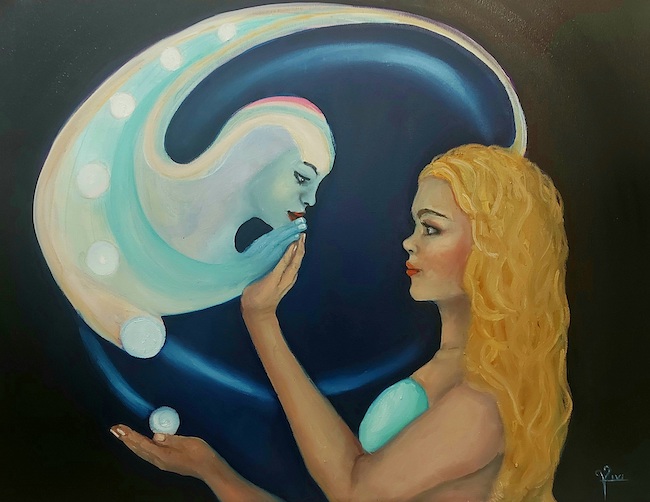
In Guardian (Guardiano), ancora una volta l’artista riproduce se stessa questa volta in contatto con il suo spirito guida, quell’angelo custode raccontato nelle favole di bambini che però nella realtà esiste davvero malgrado l’incapacità di molti adulti di credere alla sua costante presenza; la Connors riesce invece non solo ad avvertirne la presenza intorno a sé bensì ha bisogno di suggerire al fruitore quanto sia positivo e rassicurante sapere che c’è e che veglia suggerendo anche la strada migliore da intraprendere. In questo dipinto, in virtù della connessione superiore con lo spirito guida, lo sfondo è scuro pur non apparendo buio, perché c’è bisogno di silenzio, di essere soli con se stessi e in contatto con l’universo per scorgerlo e ascoltare il sussurro della sua voce.
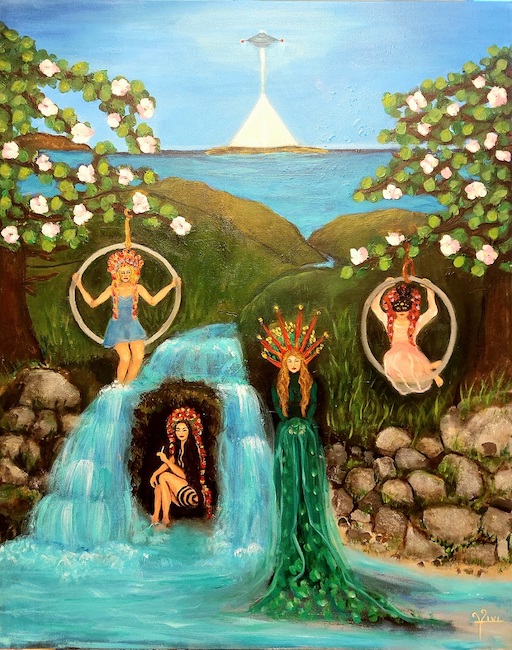
La necessità di osservare e portare alla luce tutto ciò che è inconoscibile e misterioso con approccio meravigliato e giocoso, diventa caratteristica distintiva di Vivi Connors e si palesa ancor più chiaramente nella tela In seconds (Nei secondi) dove figure mitologiche, le Ninfe, si legano agli elementi fondamentali della natura, l’acqua, i fiori, gli alberi con il verde del prato e delle chiome, sembrano vivere inconsapevolmente la loro quotidianità ignare che più in alto una navicella spaziale le osserva cercando forse un contatto, o forse semplicemente controllando che tutto sia in ordine, che possano continuare a bearsi di quella spensieratezza, di quella serenità che appare evidente dalla loro postura e dalla loro innocente spontaneità.
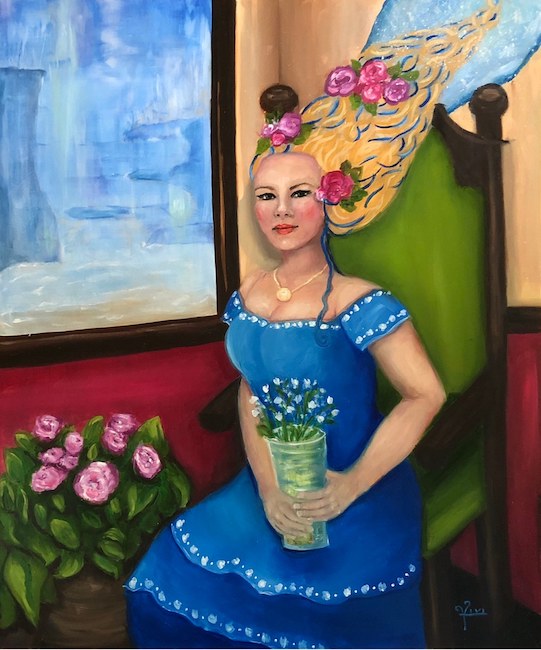
La caratteristica di immortalare spesso se stessa come protagonista delle sue opere avvicina l’artista alla grande Frida Khalo, sebbene nel caso della Connors le sensazioni siano positive, di felicità innata, di gioia, di spensieratezza; probabilmente il suo percorso di vita l’ha condotta ad approfondire molto le proprie emozioni e la propria interiorità scegliendo di mantenere quel fondamentale sguardo positivo sulla realtà vissuta che traspare dalle sue opere. Fin da bambina ha avuto uno stretto contatto con la natura e questo le ha permesso di sviluppare un amore spassionato per quegli alberi, quei fiori, che contraddistinguono le sue tele e che sono cornice perfetta per il suo mondo sognante, idilliaco in cui tutto ha un proprio ordine, un proprio senso volto a rendere l’esistenza più bella di quanto immaginabile. Vivi Connors ha all’attivo molte mostre personali in Norvegia ed esibizioni collettive anche a New York e a Roma, riscuotendo sempre grande successo di pubblico e apprezzamento dagli addetti ai lavori per la capacità di trasportare l’osservatore nel suo mondo da favola.
VIVI CONNORS-CONTATTI
Email: vivithe111@gmail.com
Sito web: www.viviconnors.com
Facebook: https://www.facebook.com/vivi.connors
Instagram: https://www.instagram.com/viviconnors/
Contact with nature and listening to higher energies in the fantasy world of Vivi Connors
The innate tendency of the human being to wonder about the mysteries of the universe has always distinguished a large group of artists who, each with their own personal expressive language, have told of that part of mystery, of the inexplicable, in which everyday reality is immersed and which man often forgets to listen to; the task undertaken by these creatives is therefore to highlight the connection between objectivity and sensation, between spirituality and higher forces that interact with the world, giving life to a parallel dimension that in fact, albeit silently, interacts with and guides people’s existence. Today’s protagonist chooses to allow the subtle magic that surrounds life to emerge through a dreamy, soft and reassuring style, with which she narrates everything invisible that revolves around the individual.
Throughout the history of art, contact with spirituality has long been neglected in order to give priority to the perfection of the details, the relevance to the reality observed and the strong link with the academic rules that had to determine a perfection in the reproduction of the image that prevailed over any interference of the artist’s interiority. However, there were some movements even in the centuries preceding the twentieth, the absolute turning point in the approach to art, which decided to highlight precisely those subtle energies, that contact with spirituality and interiority that are too often ignored. The first to speak of immateriality, of all that seems to exist latent beneath the surface, was Hieronymus Bosch, whose fantastic and transcendental visions highlighted everything that could not be traced or explained by reason; with him a link began to emerge with the first psychoanalytical theories on the unconscious, which were studied and explored in depth by the much later Surrealists inspired by the studies of Sigmund Freud. At the end of the eighteenth century, many decades later, Romanticism was founded in Germany, which gave pride of place to the sensations, fantasy, imagination and interpretation of the individual artist regarding panoramas and scenes of historical or mythological events; in this artistic style what was important was the feeling, the emotional depth that had to transpire from the canvases to reach the inner chords of the observer who could not help but reflect on that intimate world of which the artist told.
At the end of the 19th century, Symbolism took up the themes of feeling, of perception, linking them however more to listen to the energies around the human being that had to be listened to through intuition, spirituality with which to investigate everything that is not visible to the human eye, subjectifying the images reproduced with the filter of sensation. Finally, in the 20th century, there was a total opening up to the emotional world, to contact with everything that surrounds the human being on an unconscious level, more or less aware; among the most important movements in this sense were Surrealism, Metaphysics, part of the Naïf movement, the South American one, and finally Magic Realism, all movements that sought to find a connection between what man experiences every day and all those hidden, subtle and imperceptible realities that move around and remain linked to a sense of mystery. The Norwegian artist Vivi Connors approaches both Naif and Magic Realism to describe her world in which contact with nature is the fundamental basis of her pictorial research as she describes the important role that man’s surroundings play in accompanying everyday life, and here she links up with the Naïf style for the meticulous description of details and the miniaturization of the characters placed within the natural context, but at the same time she also evokes the idyllic setting within which to find the connection with everything that revolves invisibly around the protagonists of her canvases, showing in this her tendency towards Magic Realism. She speaks of souls, of incursions from space that do not appear threatening, on the contrary, they seem to watch over and protect the world they vigil, as if the continuation of the harmony necessary for human beings not to stop being human depended on them.
Connors’ fairy-tale world is an invitation to the observer not to lose contact with his own childish side, the side that still allows him to dream, to imagine places and situations that are different from those found in reality and yet equally possible if only the adult did not stifle his fantasy, his imagination. From this point of view, that of pictorial intention, the artist thus comes close to the symbolist themes, even if in her case contact with the outside world is linked to the most pleasant, pure, innocent emotions that fearlessly listen to all that mystery and supernatural aura that inevitably envelops everyday life and often goes unheard, partly through distraction, partly through superficiality and partly through that unmanageable fear of the unknown that characterises people of all ages. In the canvas She Loves You, Vivi Connors shows an attitude of letting herself go to listen to those subtle energies, and not only that, she also allows that whispered world to lift her up to reassure her and show her how is positive the closeness of what appear to be alien creatures, but protective, smiling, as if they wanted to take care of her soul and safeguard it from adversity; the woman narrated, ideally the artist herself, is therefore happy, serene, satisfied in observing the world from the height of her sphere of security. The colours chosen harmonise with the narrative atmospheres, playing with pastel shades of pink and light blue to emphasise the beauty of a childlike gaze on the world. In Guardian, the artist once again reproduces herself, this time in contact with her spirit guide, that guardian angel recounted in children’s fairy tales who, however, really exists in reality despite the inability of many adults to believe in his constant presence; Connors, on the other hand, not only manages to sense his presence around her but needs to suggest to the viewer how positive and reassuring it is to know that he is there and that he is watching over us, suggesting the best way forward. In this painting, by virtue of the higher connection with the spirit guide, the background is dark although it does not appear gloomy, because there is a requirement for silence, to be alone with oneself and in contact with the universe in order to perceive it and hear the whispering of its voice.
The need to observe and bring to light all that is unknowable and mysterious with a marvellous and playful approach becomes a distinctive characteristic of Vivi Connors and is even more evident in the canvas In seconds where mythological figures, the Nymphs, are linked to the fundamental elements of nature, water, flowers, trees with the green of the lawn and foliage, They seem to be unconsciously going about their daily lives, unaware that higher up a spaceship is watching them, perhaps seeking contact, or perhaps simply checking that everything is in order, that they can continue to enjoy the carefree, serene atmosphere that is evident from their posture and innocent spontaneity. The fact that the artist often immortalises herself as the protagonist of her paintings brings her close to the great Frida Khalo, although in Connors’ case the sensations are positive, of innate happiness, joy and light-heartedness; probably her life path has led her to delve deeply into her emotions and interiority, choosing to maintain that fundamental positive outlook on lived reality that shines through in her artworks. Ever since she was a child she has had close contact with nature and this has allowed her to develop a passionate love for those trees and flowers that distinguish her canvases and are the perfect frame for her dreamy, idyllic world in which everything has its own order, its own meaning, aimed at making existence more beautiful than imaginable. Vivi Connors has had many solo exhibitions in Norway and group exhibitions also in New York and Rome, which have always been very well received by the public and the experts for her ability to transport the viewer into her fairytale world.


